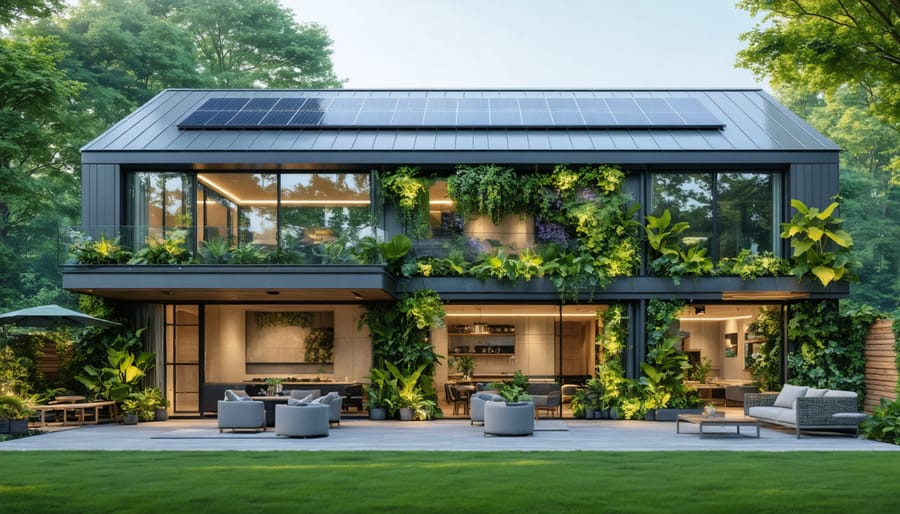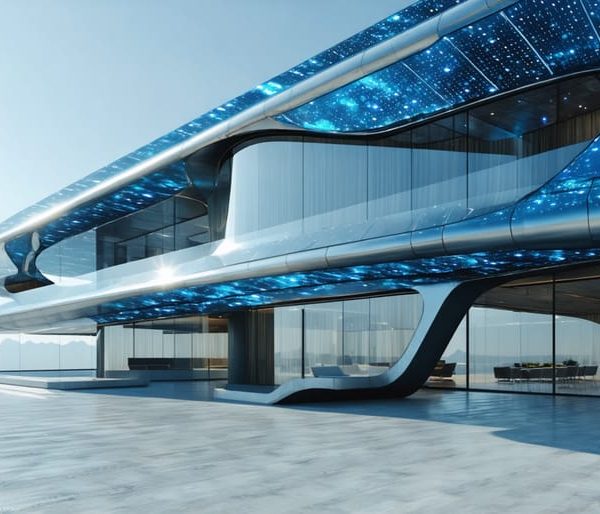Solar Architecture That Brings Nature Into Your Home (And Slashes Energy Bills)
Solar architecture revolutionizes how we think about sustainable living spaces, merging clean energy production with stunning architectural design. By integrating photovoltaic panels directly into building elements like windows, roofing, and façades, modern structures can generate their own power while maintaining aesthetic appeal. This innovative approach transforms buildings from passive energy consumers into active power generators, reducing carbon footprints while creating visually striking spaces that connect with nature.
Beyond simple solar panel installation, today’s solar architecture encompasses smart design principles that maximize natural light, regulate temperature, and create harmony between built environments and natural ecosystems. Architects now design structures that track the sun’s movement, incorporate energy-storing materials, and utilize advanced glass technologies that transform from transparent to opaque based on sunlight intensity.
The fusion of biophilic design with solar technology creates buildings that not only harvest clean energy but also enhance human wellbeing through connection with nature. From living walls powered by solar-driven irrigation systems to sun-tracking facades that adjust throughout the day, these innovations are making sustainable architecture more accessible and appealing than ever before.
Where Nature Meets Solar Innovation
The Science Behind Living Solar Spaces
Living solar spaces represent a harmonious blend of nature and technology, where biophilic design principles work together with solar innovations to create environments that are both sustainable and nurturing. Plants and natural elements play a crucial role by providing natural shade in summer while allowing sunlight to penetrate during winter months. This strategic placement helps optimize solar panel efficiency while creating comfortable indoor temperatures.
The integration of natural materials like wood and stone helps regulate humidity and temperature, working in tandem with solar heating systems. Large windows and skylights don’t just let in natural light; they’re often equipped with photovoltaic elements that capture solar energy while maintaining the connection to outdoor spaces that biophilic design emphasizes.
Living walls and indoor gardens contribute to better air quality and natural cooling, reducing the energy load on solar-powered HVAC systems. Water features, powered by solar energy, add both aesthetic value and help maintain optimal humidity levels. This synergy between nature-inspired design and solar technology creates spaces that are not just energy-efficient but also promote well-being and environmental harmony.
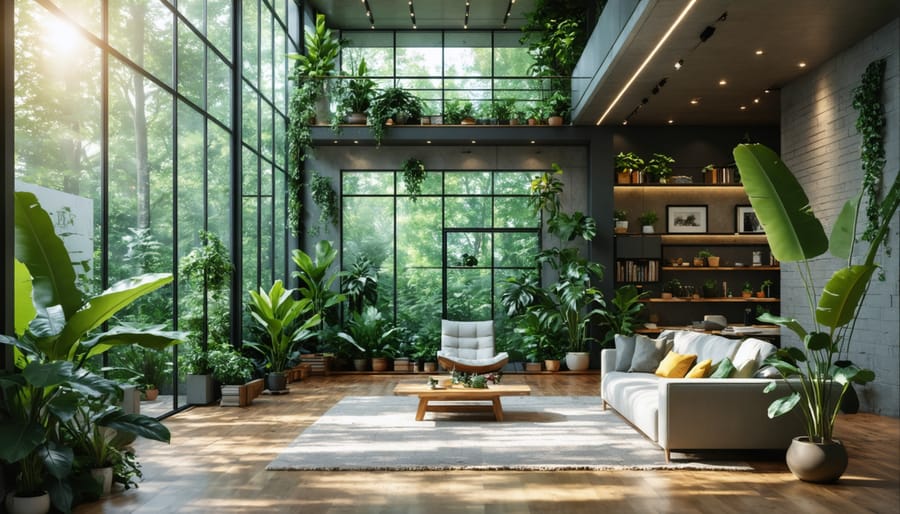
Health and Wellness Benefits
Solar architecture does more than just save energy – it creates spaces that enhance our overall well-being. Natural daylight, a key component of solar design, helps regulate our circadian rhythms, improving sleep patterns and reducing seasonal affective disorder (SAD). Studies show that people working in naturally lit spaces experience better mood, increased productivity, and reduced eye strain compared to those in artificially lit environments.
The integration of solar features often includes elements like green spaces and natural ventilation, which significantly improve indoor air quality. Better air circulation reduces the concentration of indoor pollutants and helps maintain optimal humidity levels, decreasing the risk of respiratory issues and allergies.
The connection to nature through solar-optimized windows and outdoor views reduces stress levels and blood pressure while boosting cognitive function. This biophilic aspect of solar architecture has been linked to faster recovery rates in healthcare settings and improved learning outcomes in educational facilities.
Additionally, the thermal comfort achieved through passive solar design creates more pleasant indoor environments, reducing temperature-related stress and promoting better physical comfort throughout the year.
Key Elements of Biophilic Solar Design
Natural Light Integration
Natural light integration is a cornerstone of effective solar architecture, combining energy efficiency with aesthetic appeal. By maximizing natural light, buildings can reduce their reliance on artificial lighting while creating dynamic, welcoming spaces. Strategic placement of windows, skylights, and light wells can channel sunlight deep into living spaces, transforming them throughout the day.
To optimize solar gain, architects carefully consider building orientation and window placement. South-facing windows capture maximum sunlight during winter months while properly designed overhangs prevent excessive heat during summer. Light-colored interior surfaces and reflective materials help bounce daylight deeper into rooms, creating an even distribution of natural illumination.
Light shelves – horizontal surfaces mounted above eye level – are particularly effective at directing sunlight toward ceilings, which then diffuse it throughout the space. These features work alongside clerestory windows and solar tubes to create layered lighting that adapts to changing weather conditions and seasonal variations.
The key to successful natural light integration lies in balance. Too much direct sunlight can cause glare and overheating, while insufficient light leaves spaces feeling gloomy. Smart design solutions like electrochromic glass, automated blinds, and light-filtering screens help maintain optimal lighting levels throughout the day, ensuring comfort while maximizing energy savings.
Living Walls and Solar Panels
Living walls and solar panels are revolutionizing modern architecture by creating a harmonious blend of nature and sustainable technology. This innovative approach combines vertical gardens with solar panel integration, maximizing both energy efficiency and aesthetic appeal.
The vertical garden system typically consists of modular panels filled with soil and plants, mounted on a building’s exterior walls. These living walls are strategically positioned to complement solar panels, with careful consideration given to shade patterns and sun exposure. The plants help regulate building temperature by providing natural insulation, while the solar panels generate clean energy.
This dual-purpose solution offers multiple benefits. The vegetation helps cool the solar panels, increasing their efficiency by up to 15%. Meanwhile, the panels provide partial shade for certain plant species that thrive in filtered sunlight. The combination also improves air quality, reduces urban heat island effects, and creates habitats for local wildlife.
Installation requires careful planning to ensure both systems work together effectively. The living wall’s irrigation system must be designed to prevent water damage to electrical components, while plant selection should focus on species that won’t interfere with panel maintenance. Popular choices include sedums, ferns, and native perennials that require minimal upkeep.
Property owners report significant reductions in energy costs and increased property values after implementing these integrated systems. The visual impact of green walls combined with sleek solar technology creates an inspiring example of sustainable architecture that appeals to both environmentally conscious designers and practical-minded investors.
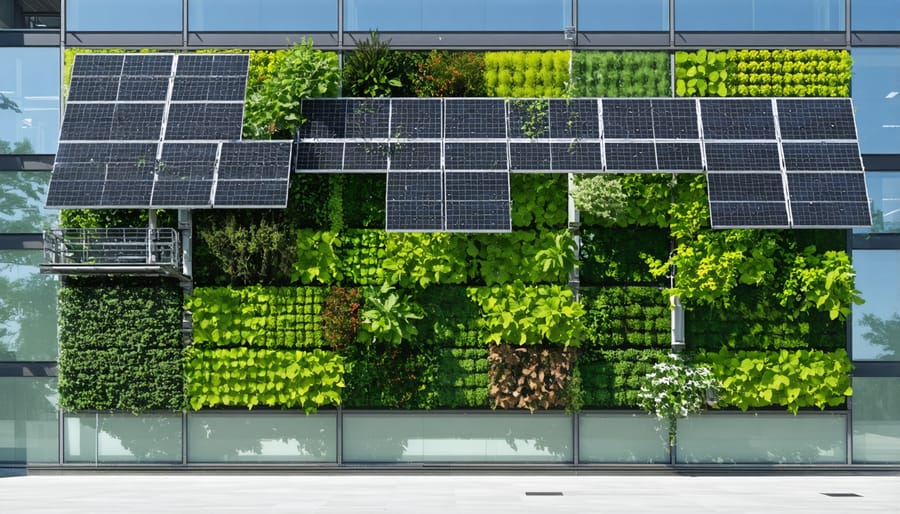
Sustainable Materials and Solar Solutions
The integration of sustainable materials with solar technology creates a powerful synergy in modern solar architecture. Eco-friendly building materials like recycled steel, bamboo, and reclaimed wood work harmoniously with solar components to maximize both energy efficiency and environmental benefits.
When selecting materials for solar-integrated buildings, durability and thermal performance are crucial factors. Materials like low-emission glass and phase-change materials help regulate indoor temperatures while complementing solar panel efficiency. Structural insulated panels (SIPs) provide excellent insulation while creating ideal mounting surfaces for solar installations.
Smart material choices extend beyond the main structure. Solar-ready roofing materials, including specially designed tiles and metal panels, are now available with built-in mounting systems that simplify installation while maintaining water-tight integrity. These integrated solutions eliminate the need for traditional rack mounting systems, resulting in cleaner aesthetics and reduced installation costs.
For exterior walls, materials like thermally modified wood and recycled composite cladding offer durability while reducing the building’s carbon footprint. These materials can be strategically placed to enhance natural ventilation and solar gain during winter months.
The key to successful integration lies in early planning. Working with manufacturers who specialize in solar-compatible building materials ensures seamless incorporation of renewable energy systems while maintaining the highest standards of sustainability throughout the construction process.
Practical Implementation Steps
Assessment and Planning
Before diving into solar architecture implementation, a thorough assessment of your space and careful planning are essential for success. Start by evaluating your property’s solar potential through a site survey, which includes analyzing sun exposure, shade patterns, and structural integrity of your building.
Consider tracking sunlight throughout different seasons using sun path diagrams or digital tools. Pay special attention to obstacles like neighboring buildings, trees, or geographical features that might affect solar exposure. Your roof’s orientation, angle, and available surface area are crucial factors that will influence the system’s efficiency.
Next, assess your energy needs by reviewing utility bills from the past year. This helps determine the size of the solar installation required to meet your goals. Consider future changes in energy consumption, such as adding electric vehicles or home additions.
Create a detailed implementation strategy that includes:
– Budget allocation for materials and installation
– Timeline for permits and construction
– Selection of appropriate solar technologies
– Integration with existing architecture
– Maintenance requirements
– Backup power solutions
Work with certified solar designers who can help optimize your plan and ensure compliance with local building codes and regulations. They can also recommend the best materials and technologies for your specific situation.
Remember to factor in local climate conditions, seasonal variations, and potential future developments in your area that might affect solar access. A well-planned solar architecture project leads to better results and higher returns on investment.
Cost-Effective Solutions
Incorporating solar architecture doesn’t have to break the bank. There are numerous budget-friendly approaches that can help you embrace both solar efficiency and biophilic design principles. Start with passive solar solutions like strategically placed windows and thermal mass materials, which require minimal upfront investment while providing significant energy savings calculations show these features can pay for themselves within 2-3 years.
Consider modular solar panels that allow for gradual installation based on your budget. Many homeowners begin with a small array covering essential power needs and expand over time. Living walls combined with solar panels can be achieved cost-effectively using climbing plants like ivy or virginia creeper, which naturally create vertical gardens while providing shade and cooling effects.
DIY solar projects, such as solar water heaters or simple window overhangs, offer affordable entry points into solar architecture. Local recycling centers often have materials suitable for thermal mass applications, like concrete blocks or water barrels, at fraction of retail costs.
Take advantage of government incentives, tax credits, and rebates to offset initial expenses. Many utilities offer net metering programs, allowing you to sell excess power back to the grid. Community solar programs provide another avenue for accessing solar benefits without installing panels on your property, making sustainable living more accessible to everyone.
Remember, implementing these solutions gradually allows you to spread costs while immediately beginning to enjoy the benefits of solar architecture.
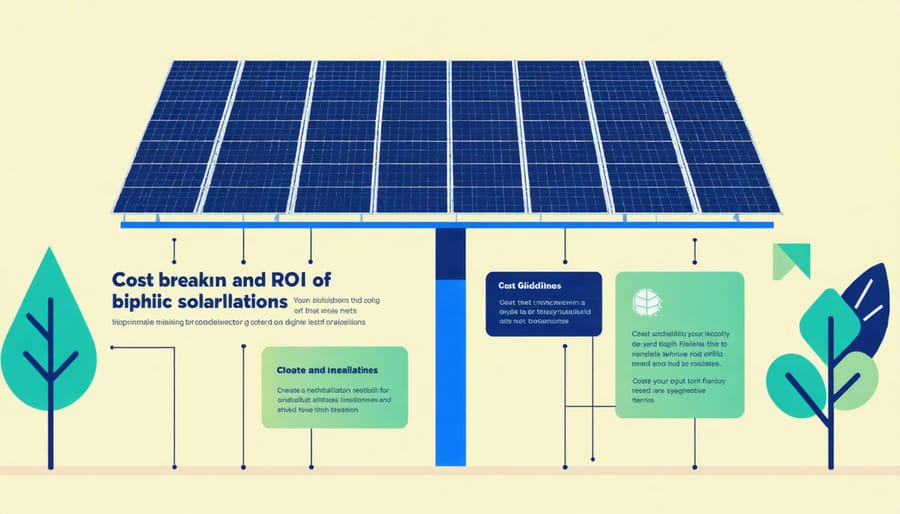
Professional Support
While DIY solar projects can be tempting, working with qualified professionals is crucial for successful solar architecture implementation. The best approach is to start by consulting a solar-certified architect who can evaluate your property’s potential and create a comprehensive design that maximizes solar efficiency while maintaining aesthetic appeal.
Look for architects with LEED certification or specific solar design credentials. They can help integrate solar elements seamlessly into your building’s architecture, whether you’re renovating or building from scratch. These professionals understand both the technical requirements and local building codes, ensuring your project meets all regulatory standards.
When it comes to installation, partner with certified solar installers who have experience with architectural integration. They should be able to show you a portfolio of similar projects and provide references. The best installers will work closely with your architect to ensure the solar components are installed exactly as designed.
Timing is also crucial. Involve both professionals early in the planning phase to avoid costly modifications later. They can help you:
– Assess site conditions and solar potential
– Calculate energy requirements
– Select appropriate materials and technologies
– Navigate permitting processes
– Coordinate installation schedules
– Ensure proper system integration
Remember to get multiple quotes and check credentials carefully. While professional services add to initial costs, their expertise helps avoid expensive mistakes and ensures optimal system performance for decades to come.
Solar architecture represents a powerful fusion of sustainable design and renewable energy technology that’s transforming how we think about our built environment. As we’ve explored throughout this article, the benefits of incorporating solar principles into architectural design extend far beyond energy savings, touching every aspect of our lives and the planet’s well-being.
By embracing solar architecture, homeowners and businesses can significantly reduce their carbon footprint while enjoying substantial energy cost savings. The initial investment in solar features typically pays for itself within 5-7 years, while providing decades of clean, renewable energy. Moreover, properties with solar installations often command higher resale values and attract environmentally conscious tenants or buyers.
The aesthetic appeal of modern solar architecture proves that sustainability and beauty can coexist harmoniously. From seamlessly integrated solar panels to passive solar design elements, these features enhance rather than detract from a building’s visual appeal. The marriage of natural light, thermal efficiency, and renewable energy creates spaces that are not just environmentally responsible but also more comfortable and healthier for occupants.
The time to act is now. Climate change continues to pose unprecedented challenges, but solar architecture offers a practical and powerful solution. Whether you’re planning a new construction project or considering retrofitting an existing building, there are numerous ways to incorporate solar principles into your property.
Start small by consulting with a solar architect or energy efficiency expert to assess your property’s potential. Consider implementing passive solar design elements in your next renovation project, or explore the possibility of installing solar panels. Every step toward solar integration, no matter how modest, contributes to a more sustainable future.
Remember, solar architecture isn’t just about installing technology – it’s about creating a lasting legacy of environmental stewardship while enjoying the immediate benefits of reduced energy costs and enhanced living spaces. By embracing these principles today, you’re investing in a brighter, cleaner, and more sustainable tomorrow.

